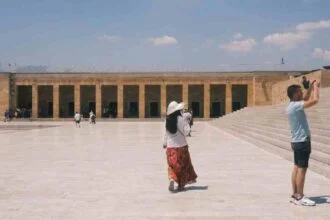Here’s the Story of Red Gold: Saffron From Pampore, Kashmir
Saffron is a crop that is grown from the Crocus sativus flower, which is a member of the iris family. Saffron is primarily grown in Iran, Spain, India, Greece, and Morocco, although it can also be grown in other parts of the world with the right climate and soil conditions.
Read about Himalayan salt
The saffron crocus flower blooms in the fall, and each flower produces three stigmas, which are the part of the flower that is used to make saffron. The stigmas must be carefully handpicked and dried to produce saffron threads, which are then used as a spice in cooking.
Saffron is also a crop that requires specific climate and soil conditions to grow. The soil must be well-drained and rich in organic matter, and the climate must be dry and sunny with cool nights. Saffron is typically grown in areas with hot, dry summers and cold winters, such as the Mediterranean region.
Why is Saffron Called “The Red Gold”
Saffron is often referred to as “Red Gold” due to its high value and the rich, golden-red colour it imparts to dishes. Saffron is one of the most expensive spices in the world, with prices ranging from $5 to $30 per gram, depending on the quality and origin of the saffron.
The high cost of saffron is due to the fact that it is a labour-intensive crop that requires a lot of manual labour to harvest. Each saffron crocus flower produces only three stigmas, which must be carefully handpicked and dried to produce saffron threads. It takes around 75,000 saffron flowers to produce just one pound of saffron, which is why it is so expensive.
The rich, golden-red colour of saffron is another reason why it is called “Red Gold”. Saffron is often used as a natural food colouring agent and can add a beautiful golden hue to dishes such as rice, soups, and stews. The colour of saffron comes from the chemical compounds crocin and picrocrocin, which are found in the stigmas of the saffron flower.
Kashmir is a land graced with an unparalleled landscape of natural beauty. To many, it’s “heaven on Earth”, a natural, mesmerising paradise surrounded by the Himalayas and brimming with vast lakes and abundant flora and fauna. The climate is largely influenced by the mountains. Temperatures vary greatly, ranging from extreme cold in Ladakh to moderate in Kashmir and sub-tropical in Jammu. Numerous flowers, herbs and medicinal plants grow in Kashmir as do maple and apple trees, birch trees and the lovely Chinar tree.
Origin of Saffron In kashmir
The origin of saffron cultivation in Pampore, Kashmir is not entirely clear, but it is believed to have been introduced to the region by Persian traders who travelled along the Silk Road. The Silk Road was an ancient network of trade routes that connected China, India, and the Mediterranean region, and it was an important conduit for the exchange of goods, ideas, and culture.
It is believed that the Persians brought saffron bulbs with them when they travelled to Kashmir, and that they began cultivating the spice in the region. Over time, the local farmers in Pampore learned how to cultivate saffron themselves, and the spice became an important part of the local economy and culture.
The climate and soil conditions in Pampore are ideal for saffron cultivation, and the local farmers have been able to produce some of the finest saffron in the world. The saffron fields in Pampore are typically small, family-owned plots of land, and the saffron crocus flowers bloom for only a few weeks each year, usually in October and November.
The Story Of Saffron In kashmir
Saffron is a spice that is highly valued for its unique flavour and aroma. It is also one of the most expensive spices in the world. The majority of the world’s saffron is produced in Iran, but there is a small region in India that is also known for its high-quality saffron: Kashmir.
Kashmir is a region in the northernmost part of India, known for its stunning natural beauty and rich cultural heritage. It is also home to some of the finest saffron in the world. The saffron fields in Kashmir are located in the Pampore region, which is about 15 kilometres from the city of Srinagar.
The saffron fields in Kashmir are typically small, family-owned plots of land. The saffron crocus flowers bloom for only a few weeks each year, usually in October and November. During this time, the framers carefully hand-pick the delicate flowers and extract the stigmas, which are the part of the flower that contains the saffron spice.
The process of harvesting saffron is incredibly labour-intensive, as each flower only produces three stigmas, and it takes around 75,000 flowers to produce just one pound of saffron. The stigmas are then dried and packaged for sale.
Despite the high cost of saffron, it is an important part of Kashmiri cuisine and culture. It is used in a variety of dishes, including biryanis, curries, and desserts. It is also used in traditional Kashmiri medicine, as it is believed to have a number of health benefits.
Challenges faced by the Saffron Industry in Kashmir
The saffron industry in Kashmir has faced a number of challenges in recent years, which have had a significant impact on saffron production and the livelihoods of the farmers who depend on it. Some of the major challenges faced by the saffron industry in Kashmir include:
1. Political instability: Kashmir has been the site of a long-standing conflict between India and Pakistan, which has led to political instability and violence in the region. This has made it difficult for farmers to access markets and has disrupted the supply chain for saffron.
2. Climate change: Climate change has had a significant impact on saffron production in Kashmir. Changes in temperature and rainfall patterns have affected the timing of the saffron harvest, and have also led to an increase in pests and diseases that can damage the saffron crop.
3. Competition from other regions: Iran is the largest producer of saffron in the world, and its saffron is often cheaper than the saffron produced in Kashmir. This has made it difficult for Kashmiri farmers to compete in the global market.
4. Lack of infrastructure: The saffron industry in Kashmir lacks basic infrastructure, such as roads, electricity, and irrigation systems. This makes it difficult for farmers to transport their crops to market and to irrigate their fields during the dry season.
Despite these challenges, many farmers in Kashmir remain committed to preserving the saffron industry and to producing high-quality saffron. The government of India has also taken steps to support the saffron industry in Kashmir, including providing subsidies for saffron cultivation and investing in infrastructure development
Saffron bloom In Kashmir
Saffron bloom refers to the period of time when the saffron crocus flowers bloom and the stigmas are harvested to produce saffron spice. The saffron crocus is a small, purple flower that blooms for only a few weeks each year, usually in October and November.
Come autumn (October-November), Pampore will be filled with pretty purple flowers. But they are not your ordinary flowers. From these flowers comes the world’s most expensive spice – saffron.
A dark colour, light and humidity and good elasticity indicate a good and fresh stock of Saffron. The darker the colour, the better the quality.
Best time to visit Pampore to witness Saffron Harvesting
The best time to visit Pampore to witness saffron harvesting is usually in the months of October and November. This is when the saffron crocus flowers bloom and the stigmas are harvested to produce saffron spice.
During this time, the saffron fields in Pampore are a beautiful sight to behold, with rows of purple flowers stretching as far as the eye can see. Visitors can watch as the framers carefully hand-pick the delicate flowers and extract the stigmas, which are the part of the flower that contains the saffron spice.
Visitors can also learn about the history and culture of saffron cultivation in Kashmir, and can sample some of the delicious saffron-infused dishes that are a staple of Kashmiri cuisine.
It is important to note that the saffron bloom is a short-lived event, and the exact timing can vary from year to year depending on weather conditions. It is a good idea to check with local tour operators or the Jammu and Kashmir Tourism Department for the latest information on saffron harvesting and to plan your visit accordingly.
Don’t fall for people selling cheap quality Saffron, here is how you can check the authenticity
There are several ways to check if saffron is authentic:
1. Check the colour: Authentic saffron has a deep red colour, with a slightly lighter colour at the tips. If the saffron is too bright or has a yellowish tint, it may be fake.
2. Smell the saffron: Authentic saffron has a strong, distinct aroma. If the saffron has no smell or a weak smell, it may be fake.
3. Rub the saffron between your fingers: Authentic saffron will leave a yellowish-orange colour on your fingers when rubbed. If the saffron leaves no colour or a different colour, it may be fake.
4. Check the price: Saffron is one of the most expensive spices in the world, and if the price seems too good to be true, it probably is. If the saffron is significantly cheaper than other brands, it may be fake.
5. Buy from a reputable source: To ensure that you are buying authentic saffron, it is best to buy from a reputable source. Look for brands that are well-known and trusted, and avoid buying saffron from unknown or unverified sources.
By following these tips, you can ensure that you are buying authentic saffron and getting the best value for your money.
If Kashmir is in your bucket list do visit Pampore and if you need local support, please contact local NomadLawyer volunteer, Sabzar Ali Sheikh
Contact- 60058 75163





